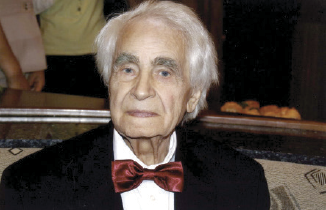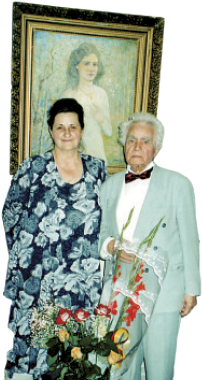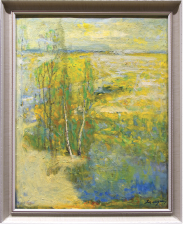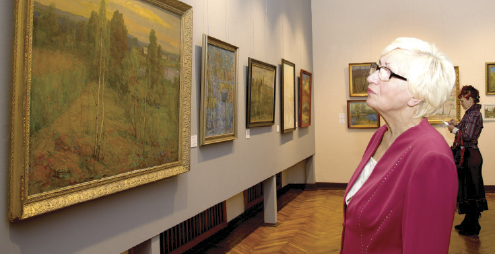
Ivan Dmukhailo
Ivan Dmukhailo’s creativity has never been represented so fully as it is today at the National Art Museum, thanks to donations by his widow, Maria Veiner, from her own collection. Moreover, photos from family albums are on show, and personal possessions once owned by the master.
The rich heritage of artist Ivan Dmukhailo, undoubtedly, comprises an attractive page in landscape painting, inspired by the scenery of Ukraine and Belarus: lyrical, rural and even urban scenes. Meanwhile, the charm of novelty endures across his legacy, despite his works’ similarity of theme.

“My family tree has many branches: one grandfather painted icons; the other directed and acted for the Kiev Drama Theatre; one uncle was a priest who, for no reason, disappeared on the Solovki; and my wonderful, cordial mother taught me to love and appreciate nature, wild and beautiful.”
Two of his teachers studied under Repin; they became his ‘godfathers’, teaching him the profession of ‘Artist’. Ivan wrote that, by the age of 85, he had realized that he had experienced ‘the Stone Age’ moving to modern days of technical progress: enduring the greatest war in history and Chernobyl, before crossing into the third millennium. Through his understanding of the majesty of nature, he became free and wise. In his role as ‘Creator’, he understood that art is a miracle of infinite metamorphosis. It exists not to invent something new but to convey the things that already exist.
Dmukhailo’s art was rooted in Ukraine, since he was born in the Ukrainian village of Topchino, in Dnepropetrovsk Region. In 1939 he completed his studies at Dnepropetrovsk Art College, moving to Belarus after the Great Patriotic War: first Brest, then Grodno, before moving to Minsk.
From Ivan Dmukhailo’s recollections:
“Being so old makes it difficult to leave the past behind. My Ukrainian childhood was hard, but I loved those days...”
As a young man, Ivan had his own opinions and took little on trust feeling the need to be convinced by his own experience. He adored melodious Ukrainian poetry and began writing his own verse, with a shade of bitterness, tainted by those hard Great Patriotic War years, and those that followed. He met many kind of souls on his way: in Brest, where he began on his creative path, then in Grodno, and then in Minsk. There, he became a well-known artist but remained always grateful to his Belarusian friends and colleagues for their support and encouragement.
 What distinguishes Ivan Dmukhailo’s creativity from that of other landscape painters? First of all, he always found his ‘own’ images in ordinary scenes to tell his lyrical story about the beauty of the Earth and its sacraments. He sought his own intonations and individual poetic voice. It is this which brings sincerity and warmth to his canvases, regardless of monumental works being directly alongside.
What distinguishes Ivan Dmukhailo’s creativity from that of other landscape painters? First of all, he always found his ‘own’ images in ordinary scenes to tell his lyrical story about the beauty of the Earth and its sacraments. He sought his own intonations and individual poetic voice. It is this which brings sincerity and warmth to his canvases, regardless of monumental works being directly alongside.
We might say that his picturesque songs are filled with some spiritual creatures. For him beauty exists in clear and harmonic relations with the sacred mysteries of Mother Nature. Such beauty is both graphic and spiritual, making nature the source of constant inspiration to the artist. This state and the perception of delicate and inspired liveliness give his landscapes wonderful mood of either lyrical tranquillity or uneasy intensity— as we feel before a thunderstorm. Taking into account this balancing between harmony and anxiety, it is hard for us to classify him. Unusually careful towards the chosen motif, Ivan Dmukhailo paints trying not to miss anything from what brings him a lively dialogue with nature. We can say only that he presents his own interpretations, rather than ‘photographic reproductions’. He brings his own reality in each of his canvases, connecting the open spaces of the Earth and the sky, in which the whole world is embodied, portrayed via careful brushstrokes: soft, quiet, and sometimes hidden in a misty haze.
From Ivan Dmukhailo’s recollections:
“I’m happy that, within the limits of what is possible, I’ve managed to show my favourite corners of blue-eyed Belarus in my canvases. Perhaps nothing of the same kind exists elsewhere in the whole universe. I understood that, in order for nature to enter our heart, confess to us while showing its fantastic charm, kindness and perfection, we must approach it with a pure soul, without being distracted by daily banalities or trivia. Only then can the lofty and beautiful be revealed to us in the most ordinary phenomenon. Gold in painting is silver, while silver is gold.”
The most plain and simplest motifs of Belarusian, Ukrainian and Russian nature inspired Ivan Dmukhailo’s many years of creativity. This feeling of the value of the whole creation surrounding us, the feeling of high fullness of earthly existence is his own, special and personal. This is a purely human peculiarity which determines much in Mr. Dmukhailo’s creativity, helping him to see something open only to him alone. His art is full of this ‘human response’: his own interpretation of that which lays before him. In this way, his canvases always have their own novelty and freshness. Although his landscapes and still-life works share similar themes, they never cease to have their own flavour.
 Ivan Dmukhailo loved life in all its forms and in its completeness. He had no favourite season, painting all with equal fervour. He feels the Earth as a living entity: ever changing yet eternal. It mattered not whether he writes the last snow or a rainy day near Logoisk, beside Grodno’s Kolozha Church, or standing before autumn birches in Minsk’s Drozdy, or admiring the March sun over the River Niemen or the glassy calm of the River Svisloch. Meanwhile, he also enjoyed painting early twilight when the day light gradually goes down and when everything ‘is covered with magic light’; those dusky moments never failed to surprise him, changing his perception of a familiar scene and lending it another secret life.
Ivan Dmukhailo loved life in all its forms and in its completeness. He had no favourite season, painting all with equal fervour. He feels the Earth as a living entity: ever changing yet eternal. It mattered not whether he writes the last snow or a rainy day near Logoisk, beside Grodno’s Kolozha Church, or standing before autumn birches in Minsk’s Drozdy, or admiring the March sun over the River Niemen or the glassy calm of the River Svisloch. Meanwhile, he also enjoyed painting early twilight when the day light gradually goes down and when everything ‘is covered with magic light’; those dusky moments never failed to surprise him, changing his perception of a familiar scene and lending it another secret life.
Ivan referred to artists boasting a strongly marked passion: Poetry. The poetry of painting and the poetry of the word: shaping colour, form and word. This brand of poetry is evident in his canvases: exhibited at the National Art Museum of Belarus. It lives in his landscapes and still-life works: big and small, sunny and sad, epical and chamber, written from nature and those created in the studio and based on his impressions, very good pictures and those not very successful. They are always sincere, without pretension, seeking only to reveal his vision of nature, in all its diverse beauty.
Ivan’s long lifetime may be compared to the ‘path of civilisation’. Being born at the very beginning of WWI, in 1914, he was at the front in the following great war. He witnessed the biggest ecological catastrophe in the history of humankind: Chernobyl, the consequences of which fell upon Ukrainians and Belarusians. Despite many hardships, he never broke his ties with nature, always worshiping and seeking balance. He comprehended its secrets, its complexities and its purity, realizing that its infinite transformations echo those of the universe. He gloried in its simplicity and never ending puzzles; it is this that marks him out as a great creator.
We are all ‘born’ of our own time, shaped by events and circumstances. It’s extremely difficult to remain an artist of one’s own time, to evolve and to constantly grow, as a big tree. Evolving beyond this is the greatest challenge. By nature, Ivan Dmukhailo was a poet-lyricist and an eternal optimist, with a note of nostalgia for his modest native land — and for the unforgettable years of youth. His Ukrainian childhood was hard, but defined his further growth. He witnessed the Holodomor famine, and the loss of relatives, bringing home the importance of word and deed. Meanwhile, against everything, against these sad, twisting circumstances of the history, he sought out the Ukrainian language, through the words of his mother’s songs.
 As a teenager, he began writing poetry in Ukrainian and continued to do it all his life. His love for his native land found expression in his native language, as we see with the course of time, and again in his creativity, where the motif of his native home is constantly presented. On the eve of war, Ivan Dmukhailo studied at Dnepropetrovsk Art School and honoured his Ukrainian teachers all his life for having taught him all they knew.
As a teenager, he began writing poetry in Ukrainian and continued to do it all his life. His love for his native land found expression in his native language, as we see with the course of time, and again in his creativity, where the motif of his native home is constantly presented. On the eve of war, Ivan Dmukhailo studied at Dnepropetrovsk Art School and honoured his Ukrainian teachers all his life for having taught him all they knew.
His youth was connected with the Great Patriotic War, and with post-war hardships: he might have descended into bitterness, fear and pain but, rather, he managed to find what is beautiful in the world. His canvases sing with cheer. He knew that one could ‘burst’ into classical painting even due to a single work, dedicated to the military events. While many artists explored the theme of war and loss, he focused on birch groves, the rustle of foliage, and the scattering of gentle spring flowers. There is no need to know which particular locations inspired him, since his canvases are likely to be a composite of all his various impressions.
The landscape genre values truthfulness and sincerity above all and, among all Belarusian masters of landscape art, Ivan Dmukhailo was notable in casting his own path and his own images. In portraying Belarus’ nature, he conveyed his own original story of eternal truth, telling us about the beauty of the Earth and its secrets through his own intonations and his unique manner. Therefore, among the large Belarusian schools of landscapes his images are distinctively poetic and melodious, with enduring integrity. Simple and plain motifs of Belarusian nature were filled with inner significance in Dmukhailo’s works. His appreciation of the whole creation drove his creativity and, thanks to his poetic gift, Ivan also loved the Belarusian word and Belarusian poetry. He knew well the works of Yanka Kupala, grasping the individualism of the People’s Poet of Belarus. His Awakening depicts Yanka Kupala with his wife and he more than once drew on landscapes connected with the great poet: in the 1960s and in the 1980s.
Ivan loved Belarus, in all its magnificence: he loved its great history and its unique landscapes, as he showed us joyfully. His canvases show us his favourite corners of this blue-eyed country, rich in lakes — as perhaps found nowhere else. By the late 1960s his naturalistic style (or, more precisely, geographical passion) had given way to generalization attempts. His canvases had become hymns of epic scope, creating an unequivocally accurate portrayal of his country.
In the 1960s a new stage of creativity began for Ivan Dmukhailo, with his Dnepropetrovsk training put aside in favour of pure innovation, inspired by Belarusian horizons. His delight in wild open spaces dictated a new, light feeling — such as is seen in At Forest Border, Dawns, and Spring Sun, which are all well-known today.
 The artist felt nature as a living entity, seeing its breath on a cloudy autumn day, in the March sun over fields in Logoisk area, and in the sky’s reflection in the waters of the Niemen River. Most of all he enjoyed the twilight hours, when everything is filled with indescribable mystery or at least the promise of mystery — as seen in his Winter (1957), Night City (1967) and Thoughtfulness (1980). He grew ever more impulsive and light of touch with age: an evident master of landscape, a brilliant master of lyrical moods, a heartfelt singer of Belarusian lakes, fields and woods, rivers, dawns and sunsets, tender spring and silent winter, sonorous autumn and hot summer.
The artist felt nature as a living entity, seeing its breath on a cloudy autumn day, in the March sun over fields in Logoisk area, and in the sky’s reflection in the waters of the Niemen River. Most of all he enjoyed the twilight hours, when everything is filled with indescribable mystery or at least the promise of mystery — as seen in his Winter (1957), Night City (1967) and Thoughtfulness (1980). He grew ever more impulsive and light of touch with age: an evident master of landscape, a brilliant master of lyrical moods, a heartfelt singer of Belarusian lakes, fields and woods, rivers, dawns and sunsets, tender spring and silent winter, sonorous autumn and hot summer.
He may have no equal in emotional depth, which is perhaps best demonstrated in his most optimistic canvas May, executed with great diligence and in impressionistic style. In line with the practice and theory of this trend, all colours exist separately while our eyes and impressions mix them in an incomparable effect. The very light seems to tremble, greater in our imagination than in reality, creating a shimmering recollection of the end of spring.
Ivan Dmukhailo happily avoided officiousness, wishing to share his love to Belarus via his legacy of hundreds of canvases. Through them, he has bequeathed a priceless documentation of our country’s scenery, seasons and moods. Each work is like a piece of music, assuaging the soul and bringing tenderness and pleasure.
Nature was probably the only empress of his thoughts and ruled his thoughts, and was the source of all his inspiration: the ultimate muse. We see unlimited peace of boundless plains, the dreamy breath of the Earth blanketed by autumn mist, the warmth of a wood thicket on the horizon, and rays of brightness of a hot summer day. His landscapes are marked by magical energy: a real presence of tranquility, melancholy, delight and excitement. Light and air are captured by his brush, testifying to richness and diversity of the atmosphere ‘palette’ and revealing to us the ideas, images and feelings always close to him. They whisper to our soul.
 Ivan loved to paint in the open air, seeking out places which spoke to him. Many of his pictures were also painted in his silent studio, relying on his impressions. He seldom depicted people, which strengthens his atmosphere of mystery and unreality. The time of day, be that dawn or dust, and the weather — drizzle, fog or sun — appear spiritual rather than physical, bringing intimacy. We are invited to draw near and to lift the curtain on his secret places, connecting with his seclusion and emotional journey. He unveiled the psychological characteristics of each landscape in a very intimate fashion, capturing exquisite moments in time. He did this without ‘show’, preferring silent meditation and romanticism, showing us not just the beauty of nature but his own state of mind. In this, he was truly remarkable among Belarusian landscape painters.
Ivan loved to paint in the open air, seeking out places which spoke to him. Many of his pictures were also painted in his silent studio, relying on his impressions. He seldom depicted people, which strengthens his atmosphere of mystery and unreality. The time of day, be that dawn or dust, and the weather — drizzle, fog or sun — appear spiritual rather than physical, bringing intimacy. We are invited to draw near and to lift the curtain on his secret places, connecting with his seclusion and emotional journey. He unveiled the psychological characteristics of each landscape in a very intimate fashion, capturing exquisite moments in time. He did this without ‘show’, preferring silent meditation and romanticism, showing us not just the beauty of nature but his own state of mind. In this, he was truly remarkable among Belarusian landscape painters.
Ivan Dmukhailo’s outlook and style, undoubtedly, shaped the development of Belarusian landscape painting. It would be fair to say that Ivan Dmukhailo is one of the few masters who ‘formulated’ the Belarusian landscape: his softness and modesty reflecting not only that of Belarusian nature, but that of Belarusian people.
He remained a dreamer, always painting, driven by his desire to penetrate the essence, sense and mystery of nature. He painted through the domination of cubism, surrealism and abstractionism, while remaining true to the realistic school of painting, with its figurative pictorial language. He was born in Ukraine, but became a ‘Belarusian Leviathan’.
An Honoured Figure of Arts of Belarus and holder of the Ukrainian order ‘For Merit’, Ivan Dmukhailo never differentiated between his two native lands. For more than 60 years, he lived in Belarus, but often spoke Ukrainian while painting Belarusian landscapes with enthusiasm. Belarus fascinated him with its soft nature colours and simple but memorable motifs; they satisfy the soul and warm the heart.
 From the very first, his works were filled with truth, as defined by the sincerity of nature. He sketched from childhood, in a free manner, although with attention to detail: wattle houses, fences topped with bottles, and sunflowers. Later, he set aside such minor aspects, favouring the portrayal of an overall impression of melancholy and nostalgia. Of course, not everything was ideal in his early works. Hoverer, his simplicity and uniformity of palette were honed over time, growing organically, until he mastered ‘the moment’. His early pieces possess an apprehension of his later works though the difference between the first steps and constancy is rather great. The painter refused from accentuating the item of depiction and shifted his attention to the lightness of impressions and the feeling of the moment. He experimented with times of the day, and the movement of light and shade, endeavouring to capture fluctuating elements, often returning to the banks of lakes and small rivers.
From the very first, his works were filled with truth, as defined by the sincerity of nature. He sketched from childhood, in a free manner, although with attention to detail: wattle houses, fences topped with bottles, and sunflowers. Later, he set aside such minor aspects, favouring the portrayal of an overall impression of melancholy and nostalgia. Of course, not everything was ideal in his early works. Hoverer, his simplicity and uniformity of palette were honed over time, growing organically, until he mastered ‘the moment’. His early pieces possess an apprehension of his later works though the difference between the first steps and constancy is rather great. The painter refused from accentuating the item of depiction and shifted his attention to the lightness of impressions and the feeling of the moment. He experimented with times of the day, and the movement of light and shade, endeavouring to capture fluctuating elements, often returning to the banks of lakes and small rivers.
Many of Ivan Dmukhailo’s landscapes now comprise the golden fund of Belarusian landscape painting: unique, soulful, emotional and expressive, regardless of whether the canvas is large or small. The art can be compared with the time. The image in Ivan Dmukhailo’s works — as if a reflection in time — is marked by the author’s special attitude towards nature and soul. Transparently thin birches become part of the balance of light and shade when painted by his brush. Wood in the Evening is distinct in being occupied by powerful pines, standing like primordial guardians of time. This isn’t merely a canvas; it shows us a landscape that touches the soul: a scene of melancholy Earthly beauty. The trees appear mythological, as if part of a pagan cult, representing the eternal. The message for the viewers is clear: the destruction of natural ties between people and nature leads to predictable and unpredictable circumstances. To do so can bring only tragedy. This may be why he rarely featured people in his works, wishing to concentrate on the eternal and infinite rather than the temporary ‘conquerors’ of the ecosphere.
 The painter also created panoramic landscapes showing the sky occupying most of the canvas yet it never dominates: rather, it is a benevolent, eternal force. Many Belarusian painters considered the sky as an accompaniment or, even, a leading theme, as an element of emotional sounding. Dmukhailo’s skies play different role; they have more purity. In Prospects, hills are alternating horizontals, fading into the infinite horizon, while a single tree is drawn to catch our eye before we ascend those slopes. It lends perspective to the wider scene, sun dappled between melting clouds, which become a natural continuation of the rolling hills. It is almost monumental.
The painter also created panoramic landscapes showing the sky occupying most of the canvas yet it never dominates: rather, it is a benevolent, eternal force. Many Belarusian painters considered the sky as an accompaniment or, even, a leading theme, as an element of emotional sounding. Dmukhailo’s skies play different role; they have more purity. In Prospects, hills are alternating horizontals, fading into the infinite horizon, while a single tree is drawn to catch our eye before we ascend those slopes. It lends perspective to the wider scene, sun dappled between melting clouds, which become a natural continuation of the rolling hills. It is almost monumental.
Ivan Dmukhailo’s talent is most revealed in his smaller, intimate works, conveying the spirit of awakening nature or the approach of winter. Wide, full rivers, narrow streams through woods and small lakes are embraced by sombre skies. We feel the coolness of the water, and the magic in bare trees. Modest in plot, we see scenes at once recognizable, though lyrical. Subdued blues, greys, lilacs and greens bring hushed peace, so that we feel the essence of this natural environment, as well as its freedom and energy. Some canvases use brighter colours and sunshine, but still retain their realism.
His large still-life works have solemnity, symbolizing something greater than a collection of vases. He wrote: ‘In order for nature to open up to us and confess, showing us its spacious and fantastic charm, and its kindness and perfection, we must approach with a pure soul, undisturbed by daily banalities. Then, the lofty and beautiful are revealed in the most simple of phenomena’.

At the jubilee exhibition of Ivan Dmukhailo’s pieces of work. Photo by Tatsiana Staliarova
More than ever, we feel the need for harmony in our world of cataclysms. As nature was a source of inspiration for Ivan Dmukhailo, so now his works are a source of appreciation and understanding for us, as his anniversary exhibition eloquently confirms.
Today, his works can be found at the National Art Museum of Belarus, the Museum of Modern Fine Arts in Minsk, the National History Museum, Belarusian State Museum of Folk Architecture and Rural Lifestyle, Mogilev’s Regional Art Museum (of P. Maslenikov), the State Literary Museum of Yanka Kupala, and at the State Literary-Memorial Museum of Yakub Kolas. They are also kept by the Belarusian Union of Artists, and in private collections across Belarus, Ukraine, Russia, Germany, France, Switzerland, Italy, Belgium and elsewhere worldwide.
By Victor Mikhailov











